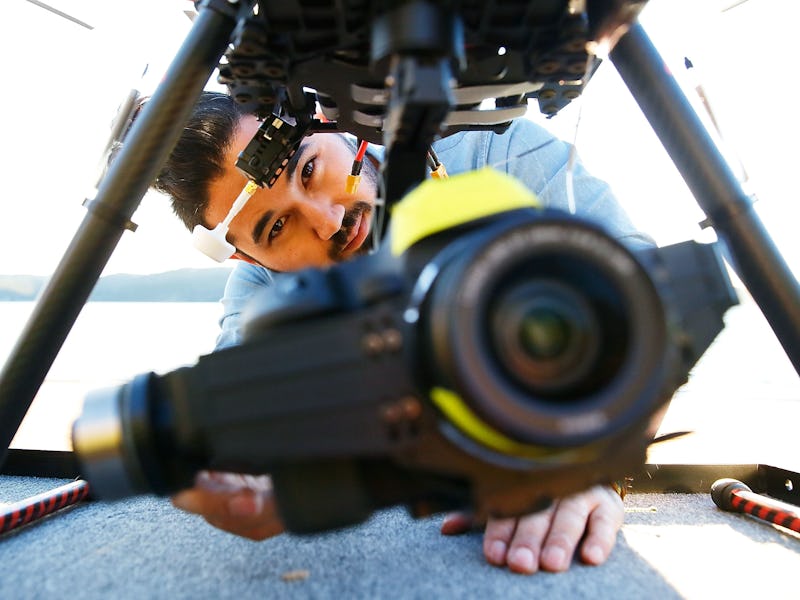
Let’s be real, drone photography isn’t just about the phenomenal shots you can take of your vacation in the Virgin Islands — it’s also about the experience of heading out into the world and getting to fly a tiny robot around.
The key is to remember that you’re really just shopping for a flying camera.
“If you get a drone you should use it to its full advantage,” says Victor Montalvo, co-founder of HiFly Photography, a company that offers for-hire drone photography. “You know, drones are awesome because they let you put a camera in places you can’t usually put it in so if you get a drone, definitely take it everywhere you go.”
When you practice flying, you're looking for something little that you're gonna crash a lot.
Buy an Affordable Drone to Learn How to Use It
When you start flying drones, you need to expect that you’re going to wreck a bunch in the beginning. So before you drop $300 on a drone and smash it on your first flight, buy one of these $15 drones and just get a sense of the controls and how not to crash.
Montalvo recommends buying a drone that’s about the cost of a good quality camera, instead of going for the $100-200 models. “If you’re wanting to take pictures that last a lifetime, even if it’s just a family event or something $300-400 is a very affordable investment.” Based on personal preference you can go for the drone plus GoPro combo, or double down on a photography-specific drone model. Montalvo says there isn’t going to be a performance difference between the two.
“Someone who has a GoPro knows how to handle it and has a soft spot for the GoPro, they may be more comfortable just attaching the GoPro to the drone,” he says. But drones with their own cameras are designed to be user-friendly, so there’s not really a benefit there. As long as you’re getting a drone with good stabilization, can rotate horizontally, and hovers, the experience will be pretty equivalent.
If you don’t already have a GoPro, Montalvo recommends something like the DJI Phantom 3 — a drone in the $400-500 range that comes with a really high-quality camera, image stabilization, and can rotate horizontally around its central axis. Having a GPS mode can also result in cool shots, where the drone stabilizes itself as it flies. Montalvo recommends buying your drone online, just because you can better compare prices and reviews for a lot of different models. “It’s a camera that flies,” says Montalvo. “Any spec that you would look for on a camera, a regular camera, you should look for on your drone, plus the battery life.”
A DJI Phantom 4 drone with a camera.
Register Your Drone If It’s Heavier Than .55 of a Pound
Once you’ve purchased your drone, there are a few things you have to keep in mind while flying that will keep you of trouble with the FAA. If it weighs more than a 0.55 of a pound, your drone has to be registered. It’s $5 for three years, and you have to register again every three years. To do it, you just have to go to the registration site, set up an account with your email, and fill out an address form. Then the government sends you a unique registration number, which you put on all your drones for the three years it’s active.
When you go to register, this is the account type you want.
The other rules are that you have to be within site of your drone at all times, you have to yield to regular planes, and if you’re within five miles from an airport, you have to tell the airport and air traffic control that you’re flying there. Most of the time, this isn’t something that most people will need to worry about, though, Montalvo says. “As long as everyone is flying it just recreationally, not charging for anything you’re doing, you always need to have line of sight with the drone and you need to keep your drone under 400 feet — and that’s pretty much it.”
It’s important to note that if you’re flying your drone as part of your job, or to sell the footage, you could be in a different class of FAA regulations, so check that out before starting your own drone photography business.
Depending on how much you think you’ll use your drone, you might want to think about purchasing backup batteries. “You usually only have 15-20 minutes battery life, depending on what drone you have, so extra batteries might be something to think about,” says Montalvo. Crashing is probably going to happen to you eventually, and propellers break, but you can purchase replacements pretty easily.
Everything else is the fun bits – taking your beautiful new drone out and getting the shot of the sun setting over the top of your house.
“There is a little bit of a learning curve, since your camera is flying, it’s a lot easier to get glare from the sun, says Montalvo. “But mostly it’s just choosing a good time of the day to take photos.”
Starting out, open spaces on calm days are the easiest as you’re getting used to your equipment, but as you get more comfortable you can branch out more.
So get out there and experiment.